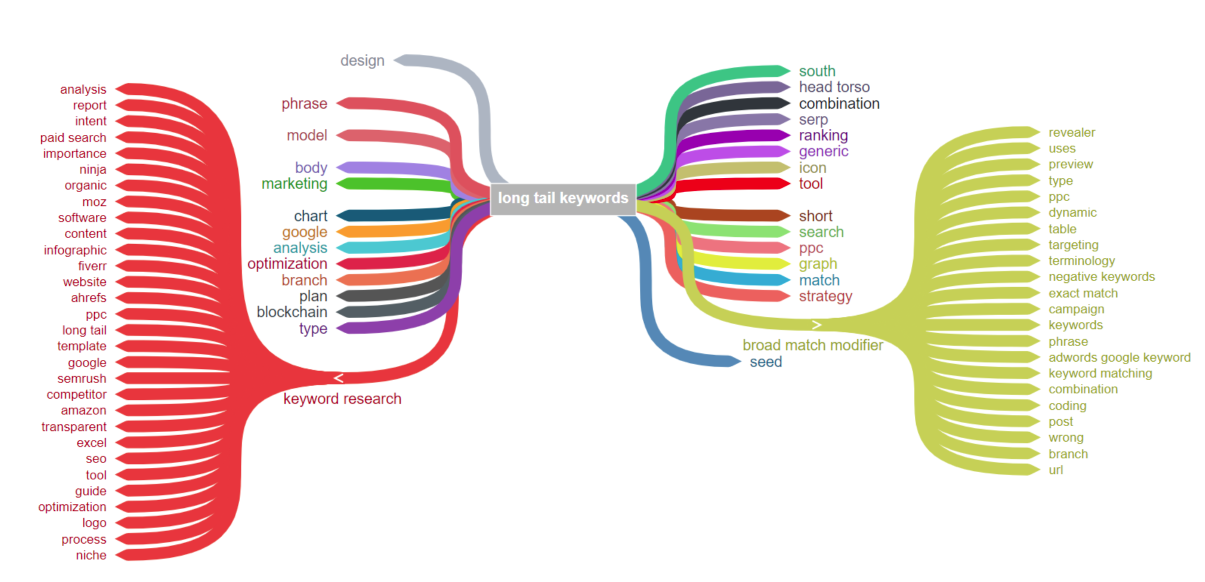Long Tail Keywords: The Key to High Conversion Rates

Facts

Using Long Tail Keywords drives huge amounts of organic traffic to your website - roughly 70% of a query’s search traffic.

A Digital Marketer’s main goal is not to drive huge amounts of traffic to a website. If only marketing was that easy.
SEO is only the first step, and gaining impressions is but the tip of the huge Iceberg which is your marketing funnel.
Conversions means sales.
Conversions means profit.
Conversions means growth for your business.
Your Number One Goal in Marketing: Conversions, not Impressions
So let’s look into how we can use Long Tail Keywords for the right purpose: Increase your Conversions.

Most experts will tell you that gaining conversions is a numbers game. And they are right. Just not the numbers that you’re thinking about.
Let’s say you manage to drive 10,000 organic traffic to a product page in a month. With an average of 2.35% conversion rate online, that means a possibility of 250 customers buying your products or services online, or reserving a slot to an event you’re hosting.
Now take a step back. How did you get 10K organic visitors in the first place?
Here are the requirements you have met:

You optimized your page for a broad search keyword that has more than 30,000 in monthly search volume.

You ranked as the first result in SERP for that broad search keyword.

Existing on the top spot means you have an average CTR of 31.7%, with a margin of error taken into account.
Awesome, right? You can definitely do that too. All you have to do now is beat the big shot websites who are also gunning for the same broad search keywords. And depending on your business’ niche, you’re looking at names ranging from Wikipedia, Amazon, IGN, Neil Patel, Facebook, CNN, and most often than not: the great Google.
Now let’s go back to that 250 customers you managed to convert.
What if I told you that you can gain the SAME number of customers by driving only 800-1000 organic visitors to your site just by utilizing Long Tail Keywords for your SEO efforts.
Too good to be true? Well, read on then. We’ll show you the science behind it.
What are Long Tail Keywords?
Long Tail Keywords are search strings that are, well, longer than a broad search one. It is actually more appropriate to refer to them as phrases instead of keywords since they’re usually composed of three or more words.
Makes sense right? But what really makes Long Tail Keywords stand out is how high its rates for conversions are.

Here’s your key takeaway:
Long Tail Keywords are phrases that your customers are more likely to enter in Google’s search bar (or use in voice search) when they are closer to a point of purchase.
Imagine placing the product you sell, or the services you provide, in front of your customer at the exact time they need it.
That’s what long tail keywords do.
It does that by utilizing a human psychological aspect that’s very important to marketers: Intent. Or, in relation to SEO: Search Intent.

Let’s say you own an online store that sells cosmetics.
Here’s a broad search keyword: red lipstick.
Upon close scrutiny, you will realize that it tells you nothing. You have no idea whether the person searching is looking to buy a red lipstick, wants to know which is better between a glossy or matte lipstick, or is looking for an eyeshadow color that will go well with it.
All we know is the color that she’s looking for. And that doesn’t help us one bit.
It will also be difficult to create content strategies since there are numerous topics possible aside from the ones I just mentioned.
Now here’s a long tail keyword: is red lipstick professional

Oh now we’re talking. This tells us that the person searching works in a corporate environment, and wants to know if wearing red lipstick will be appropriate for her line of work.
It is now possible for you to create content that would directly target your audience searching for that long tail keyword and provide value to them.
It also opens up several possibilities for you as you can also create content that:
Discusses what lipstick colors are considered professional and suggest your products that match those considerations
Discusses what events or social functions would make red lipstick appropriate
Suggest eyeshadow colors that would match with a red lipstick: An upsell opportunity!
And many more!
A word of warning, though: Most long tail keywords look bad on reports.
With the use of a Keyword Research Tool, you’ll see that these keywords or phrases are most likely to have low search volume, and that’s mainly due to how specific the intent these keywords represent.
However, due to the nature of these keywords having low search volume, you will find that there is very little competition when you target them. And that’s a win in itself.
How do Long Tail Keywords Work?
You now know why they are effective, let’s look at the “How it Works” in terms of SEO.

If Broad Search Keywords target your customers en masse like our red lipstick example in the previous section, long tail keywords target your demographics in terms of the niche they belong under.
The effects of the additional words that make these search queries longer indicates search intent.
As the search phrase becomes more detailed in its nature, your customers who use it also become more specific as to what they are actually looking for.
The search volume becomes less competitive as well. Since your big name competitors won’t be targeting them anymore.
Check out the sample graph below to see the relationship between broad search keywords and long tail keywords in terms of competition and conversions:

Why are Long Tail Keywords Important for your Site?
As if getting conversions weren’t good enough, long tail keywords also provide your website and its pages other short-term and long-term benefits due to how they correlate with search intent.

Here are other benefits of targeting (and hitting) Long Tail Keywords…

Allow you to target 70% of the search traffic for your chosen focus keyword

Allow you to rank highly in SERPs for specific topics quickly and efficiently

Make it easier for you or your content strategies to conceptualize ideas for content creation.
Target 70% of the search traffic for your chosen focus keyword
Leave your board search keywords to your competitors to fight over. Because in truth, they’re actually competing for a small part of the total search volume of your focus keywords.
70% of all the search queries you will find when doing keyword research are long tail ones.

Now don’t get me wrong, due to the nature of how specific to their search intent these long tail keywords are, it will require a lot of effort from you and your content creation team.
But if you’re in the field of SEO, then you should already know:
Organic Results require Organic Efforts.
The important thing here is that you already know what to do. More than that, with the help of long tail keywords, you know exactly how your customer thinks.
All you gotta do now, is make content that answers their search intent, and you win 70% of the traffic.

Long Tail Keywords are easy to Rank (Compared to Broad KWs)
The Top of your SERP is dominated by your big-shot competitors all vying for the top spot.
Google only has 10 slots available on any search queries’ results page. Getting ranked for the second page is out of the question. That’s a dark place, and no one goes there.
Now if you’re unlucky enough to also have marketers targeting your focus keywords through paid ads, then that already small digital real estate you’re competing for just became a whole lot smaller.
Save yourself a lot of frustration and disappointment by targeting long tail keywords instead. For one, fewer websites are competing for them.
Plus, the more specific the search terms are, the easier it becomes to find your target customers looking for a particular answer.
Here’s where the massive effort from you and your content creation team comes in: You will need to publish content that would address these specific search queries. Do so, and you will rank highly for them.
Let’s simplify that by reiterating Google’s Vision Statement:
[Google’s Vision Statement “provide an important service to the world-instantly delivering relevant information on virtually any topic”]
If your content directly answers a customer’s query, Google will rank that page as a top result in SERP.
Neat, right? Let’s look at what that means for your content creation efforts.
Long Tail Keywords make it easier to conceptualize on content creation
All content strategies start with one simple question: What do we talk about?

Unfortunately, the answer to that question is not so simple. Especially if you’re using broad search keywords as the center of the topics you’ll be conceptualizing on.
With long tail Keywords, you’ll know exactly which content topic to prioritize because it’s the one that will directly answer your customer’s needs.
But how do you actually do it? I’ll give you a tip: Throw SEO out of the window for a moment.
Focus on your customers and what they need, then create your content. If you write an awesome original content for your target audience and your goal in creating it is to genuinely help them, you’ll find that you’re automatically putting in long tail keywords without even breaking a sweat.
Add to that the fact that since your content is now bringing the right customers into your site, you will now have opportunities to create related topics to the one you’re discussing.
I call this: Dedicated Content.
Now let’s pick up the SEO considerations again - the one you threw out the window before you made your article, here are other cool stuff that dedicated content will bring to your site:
The right traffic which will lead to higher conversions
An increasing number of people that you have helped, and who are likely to remember and follow your website
Higher number of sessions on your pages
Increased session duration on your website since your customers would probably be interested in the related contents you would also be discussing
Increased repeat traffic since these customers would likely come back to your website for other related questions they may have that your content can answer for them
To summarize: Invest in your content with the intention of helping your customers by answering their questions for them and not for the purpose of helping your website rank higher in SERP.
Okay, now you know how long tail keywords work. You’re finally ready for some action, so let’s hunt these keywords down.
How do I find Long Tail Keywords?
Mining Google Search Console Data
Google Search Console is one of the best free tools for gaining keyword insights and finding long tail keywords. It is especially useful for doing in-depth analysis into the queries on your landing pages. This will allow you to find new or irrelevant keywords that your page is currently ranking for.

To do this, you’ll need to export your search queries with the following metrics: Impressions, Clicks, CTR, and Average Position.
We suggest you export up to 1,000 of the queries that your pages are ranking for in SERP.
Categorize your queries by topic so you can have an organized view of the keyword buckets that your site is getting impressions for.
What you’ll end up with is an overview of which areas you’ll need to invest more efforts in order to get more impressions and clicks within organic searches.
Next, you’ll have to look out for queries with the following characteristics:
Queries with clear search intent
Queries that sit near the bottom of SERP’s first page but still get a fair amount of clicks (more on this)
Last but certainly not the least, as this would be the part where you or your team would need to put a huge amount of effort in: Conceptualize for new content based on the long tail keywords you have chosen or improve your current ones in order to increase their rank.
Here are several tips into optimizing your content using the long tail keywords you have acquired:
After sorting your data by impressions, look for queries that have the most impressions and are also ranked in positions 3-7. Now add these keywords to your Meta Titles and the H1 of your pages.
Look for keywords that are positioned on page two or at the lowest ranks of page one that have high impressions. These are very good keywords to focus on as they have huge potential in generating traffic to your pages.
Don’t neglect your page rankings. Look for pages that ranks at positions 2-10 in SERP and focus on the keywords that they are being ranked for. If these keywords are relevant to the topic, then try to naturally include those keywords into the copy of that page.
You can also use the data you mined into optimizing Negative Keywords.
Negative keywords are queries that you’re gaining impressions and ranking for but really shouldn’t be because the content you have for that query doesn’t satisfy the user’s search intent.
One way to optimize this is to update your existing articles to accurately address keywords you’re ranking for but were not covered by your content when it was first created.
Another approach would be to create new articles that address the intent of a negative keyword, then adding links to the posts that are already ranking for it.
Let’s take a look at other methods that Google provides to us for free.

Scraping Google Suggestions
This method is a fairly easy one but is very underrated by webmasters despite it being a very potent source of long tail keywords. Probably because it’s a function that we see every time we use Google search so we tend to ignore it.
How do you actually utilize it? Start typing into the search bar and you’ll see suggested variations coming from Google itself.
It’s that easy. Plus, you can be assured that the suggestions that Google is giving you are all organic search keywords and phrases coming from actual users.
Let’s look at one more underrated tool from Google.
Google Related Searches
Another underrated source of keyword ideas, Google Related Searches provides you with suggestions in different variations like questions, prepositions, and comparisons.

To get the suggested keywords, just type in your primary query and hit search. Then scroll all the way down to the bottom of the results and you’ll see a list of phrases suggested by Google.

Image source: (https://blog.hittail.com/wp-content/uploads/sites/8/2016/10/Related-Searches.png)
You can also do expanded research on these keywords by clicking on one and then looking at the related searches on the result at the bottom part.
Similar to Google Suggests, these are actual keywords being used by Google users on the search engine.
Now these tools are certainly useful for researching long tail keywords. However, for conceptualizing your content’s outlines, you might find them wanting.
Here are some research tools you could use that you could easily integrate into your content creation process.
Finding Related Entities with Entity Explorer
Creating outlines for your articles is one of the most critical steps during content creation. This is a part of the process where a lot could go wrong.

Missing certain subtopics could lead to a non-comprehensive article about a topic you are discussing. However, there are instances when creating content so comprehensive means having numerous subtopics. This could lead to your article’s main point being lost.
For these types of situations, Entity Explorer can save you and your content creation team a lot of trouble.
Entity Explorer is a free third party online app that provides you with related intent-specific keywords that you can then utilize for creating your article outlines.
All you have to do is enter your main topic keyword on the search bar and hit enter. It will then provide you with suggestions that relate to the primary query you entered.

Need to expand further? Just click on any of the suggestions that you need more keyword ideas for and the tool would then use that as a search entry and provide you with more suggestions while still connected to the main keyword you entered.
You can also add or remove suggested keywords depending on how relevant they are to your main keyword searches. It basically writes the outline for you!
If you’re looking for question-based keywords though, our next pair of tools is for you. One of them is provided by Google as well.

Google “People also asked” or Using AnswerthePublic.com
The best source of long tail keywords would always be your customers. Knowing exactly what they are asking about and how they’re asking it would be a gold mine of content ideas for you and your team.
Google knows this and is kind enough to provide this wealth of information to you through the People Also Asked section in SERP.
These questions that Google provides can be your actual focus keywords for your content. In fact, some of these questions could also find themselves as your article’s title. Neat, huh?
All you have to do now is provide a direct accurate answer to that question through your content and voila! You land in the top spot for that specific query!
Now in case these suggestions from Google aren’t enough for you to conceptualize ideas for your content outline, you can also use third party sites like Answer The Public.
Keyword research tools like Answer the public will show you the questions that your customers are asking in relation to your main focus keywords.
You’re now fully equipped with the tools to find long tail keywords, so let’s get down to business.
How Do You Use Long Tail Keywords in Content Creation?
Alright, you now have your long tail keywords identified and it’s time for you to make awesome content. But where do you start? How do you actually utilize long tail keywords?
Well for starters, you’ll need to make sure that your content structure is rock solid. That’s where Topic Clusters come in.

Content Structured The Right Way: Topic Clusters
Topic Clusters refers to the structure of contents in your website that places your customers, their search intent, and the context that answers them as your top priority.

The idea behind this structure is that there exists a Pillar Content which contains complete and comprehensive information about a topic that your page is trying to rank for. The job of this main article is to provide support to cluster articles which would then be discussing specific subtopics related to the main content.
Let’s say your business revolves around providing financial advice to customers who need it, and you would like to rank for financial advice for retirees.
Your Pillar content would then see a main article that has everything one needs to know about retiring, its benefits, and what retirees need to keep in mind.
From the subtopics of your pillar content, you can then create specifically-targeted articles addressing topics like superannuation, what to prepare for before retirement, or national policies for retirees. These articles would then have contextual links to your pillar content which your readers could follow to gain more information related to the specific topics you are discussing.
You could also do this the other way around. This time, your pillar content would see its subtopics linking to your cluster articles.
These internal links would not only strengthen the authority of your articles in Google’s ‘eyes’, it would also exude a sense of expertise to your readers which would then lead to very high rates of organic growth.
Like everything else in digital marketing, producing success organically requires time, patience, and continuous optimization.
Don’t expect results overnight just because you found the holy grail of content marketing. Long term results usually require maximum effort, but it will definitely be worth it.
Okay, you already have a sturdy structure in place for your contents. Now it’s time to make them.

The Next step, Crafting the Essential Parts of your Article:
Headline
Your article’s headline is the first thing that your audience will see. For most, it’s the only impression that you could ever make to your customers as only 2 out of 10 people will probably read your whole article.
Without the right words that are finely crafted to catch your user’s attention and make them curious enough to click on your pages’ in search results, the rest of your article which you so painstakingly created may as well not even exist.
This is what makes your headlines very important.
Every cloud has a silver lining as they say, since your customers are looking for an article that would address their problems and solve the very questions they entered into Google’s search box. While they aren’t aware that they are doing it, your target audience is actually doing long tail searches. All that’s left for you to do is make your headlines speak to them and directly address their needs.
Here are two simple steps that you can do to integrate your long tail keywords in your article’s headline and make it compelling for your customers:
Look up Popular Headlines
First, do a little organic research on social media channels that has to do with your industry’s niche. Then Check out posts or tweets about related articles that get shared the most.
Something about the headlines used in those articles caught the attention of the customers in your industry. Ask yourself: What makes these headlines so special?
Now Craft your Headlines Based on Popular Ones
Most of the massively shared blog posts in social media had headlines that were modeled from other popular articles. So don’t be afraid to study and copy a catchy headline you see on the internet. Just make sure you create a unique and better one for your article.
There are different methods of crafting compelling headlines, some more applicable than others depending on your industry’s niche. But here are the essentials that you would always need to keep in mind:
1. Headlines need to be able to stand alone. It needs to describe your article clearly without the support of your whole content body.
2. Add your long tail keywords to your headlines but make sure you still fall within the number of allowable characters in Google’s Meta Title. This is ever changing, so make sure to stay up-to-date!
3. Don’t be afraid of lists and listicles. These short, informative, bite-sized contents are still popular even in 2020. Just make sure to deliver quality content with enough authority and expertise to back it up. And if you’re making a ranking list, remember to be fair about the positions.
4. And please, whatever you do, don’t use clickbait headlines. Never promise what you cannot deliver. It hurts your reputation, and it hurts your SERP rankings too.
The Sales Pitch: Your Article’s Introduction
Great! You now have a well written, attention-grabbing headline. Time to reinforce it with strong support statements through your introduction.

This is the make or break moment. This is the point in your article where your reader will decide to read through your content, or close the tab and look for a different one.
This is where you make your sales pitch. Your Introduction.
Let’s take a step back: You managed to get your reader through the front door using your headline. Why? What made them click on your article’s headline in SERP?The simple answer: Your headline answered their question perfectly.
Now that they’re here, and their eyes are focused on your article’s introduction, it’s time to remind them why they’re here. And there are two ways to do that

Restating their question

Affirming their need
The first one is easy: All you have to do is to redefine the query they entered on Google’s Search bar using your own words.
This is usually a hard thing to do since you can’t really read your customers’ minds. Or can you?
With the amount of research you made into long tail keywords mirroring their search intent, this step should be easy as pie.
Now, explaining the second one is a bit complicated, as it has something to do with human psychology.
So let’s simplify it with a real-life example:
Remember that feeling you felt when you were ready to buy something that you have always wanted? Only to find out that the store you entered did not have the exact make and model you were looking for?
Then the sales guy starts offering you alternatives but none of those is the one that you really wanted?
Yep, that feeling.
Affirming your customers’ needs in your introduction is like telling them: “Yep, we got what you need. You’re in the right place.”
But how do you actually go about doing it in your article, though? Well first, let’s go back to your customer’s original query.
Okay, you know their search intent. You know why they’re here. Now we dig deeper. You’re the expert in the subject, what do they really need?
Take my introduction, for example. Most Long Tail Keyword articles online would tell you that it increases impressions, drives huge traffic, and ranks your web pages higher.
And yes, that’s probably what you were looking for when you entered your search query. But what does your website, your business, really need? Conversions.
You don’t need people ‘just visiting’ your website or its pages. You need people who will buy your products and avail of your services.
Reinforce your Sales Pitch. It does wonders.

Using Keywords Naturally on Your Content’s Body
Next up is your content’s body. This is where you deliver what you promised on your headlines and affirmed in your introduction.
In order to make content that your readers will deem valuable to them, I would like to reiterate a point I made earlier in this article: Prioritize your customers before your website’s SEO.
Before you worry about integrating your long tail keywords on your articles in order to appease the SEO algorithm, think of creating high quality content first.
Not only will it support your article’s authority ratings, it would also help you avoid Keyword Stuffing.
A good method for incorporating long tail keywords in your article without being overly repetitive is LSI or Latent Semantic Indexing.
Basically, LSI considers the usage of synonyms and negative antonyms (or “not x” statements) to substitute for your specific keywords in order to avoid stuffing and repetition.
Entity Explorer and Answer the Public are some examples of LSI Keyword Tools that you could use for this purpose.

Keeping these guidelines in mind, you will notice that you are already using your long tail keywords in a seamless and very natural way while writing your articles.
Organize Your Subtopic Headers with Search Intent in Mind
Studies have shown that the average attention span of human beings is getting shorter.

However, the amount of time that people spend on the internet is getting longer. What gives?
As you know, there is no shortage of information on the internet. This means the average reader who will stumble upon your article would probably just scan it and then move on to other sources in case they don’t find what they’re looking for.
This makes your Subtopic Headers all the more important. It is a very effective weapon that you can use to counter content scanning and get your readers back on track.
Subtopic Headers usually have bolded words and have font sizes that are bigger than normal text. This makes them ‘pop out’ of your articles making them easily noticeable to the reader scanning your content.
Add to that the fact that Google’s algorithm takes into consideration what your header tags (Your < H1 > to < H6 > tags) say as well as how it’s structured in ranking pages for SERP.
Incorporating what you’ve learned about long tail keywords and how they mirror your customers search intent, it would now be a walk in the park for you to create relevant subtopic headers that addresses your readers’ needs with pinpoint accuracy.

Bonus: The Importance of Your Content’s “Flow”
Before you proceed, keep in mind this one important thought: The goal of content’s body is to have your audience read the next line. And the next, and the next, until you deliver your the whole point of your article.
This is where article transitions come into play. As much as you can, try to have a transition statement before or after your subtopic headers.
One way of doing this is by asking questions at the end of each section. Questions that will then be answered by the next section of your article which is introduced and highlighted by your subtopic headers.
Persuasive Conclusion Written with Your Long Tail Keywords
You’ve delivered your promise to your customer, it’s now time to drive the point home.

Do this by reiterating your article’s message and state the same point you did in your introduction. This would help you fortify the consistency of your content as well as the message you’re trying to deliver. Then, strengthen your content’s message further by making sure your long tail keywords are naturally integrated in your conclusion.
And that’s it! You now have a high quality, well-written content. One worthy of Google SERP’s Top Rank.
Now we’ll make the process of hunting for your long tail keywords much easier.
The Best Keyword Research Tools for Finding Long Tail Keywords
SEMRush is one of those swiss-army-knife SEO tools. It not only provides you with the capability to search for your much needed long tail keywords, it also has other neat SEO functions like site audits, competitor research, and more.
You can also use this tool to look for keywords based on certain considerations like geographic locations, demographics, and niches.
SEMRush is not for free though. However, if you’re a business who relies on online traffic, then it is definitely a tool worth having in your shed.
Ubersuggest is an all-rounder SEO Tool by Neil Patel. It’s a free tool that allows you to search for focus and long tail keywords easily and seamlessly. All you gotta do is enter your main keyword and Ubersuggest will provide you direct, related, and even question-form suggestions.
Don’t know where to start? Enter your website’s address on the tool and let it’s search function scan your site’s pages for dominant and relevant keywords. It will then give you the suggestions based on the topics that are currently being featured and discussed on your website.
Ubersuggest also gives you a peek into the SEO strategies that are working for your competitors for you to adopt and improve in order to gain the upper hand. Utilizing the Top SEO Pages report will also help you find out which keywords your competitor’s pages are ranking for.
Have I already told you that this tool is free?
Okay let’s just get this out of the way: Ahrefs is not a person. It is a one-stop-shop for people like us who dabble into the mystical art of Digital Marketing. It is also one of the best keyword research tools available for content creators.
What makes it special is its use of clickstream data to provide unique click metrics from broad search keywords. It then uses these metrics to provide you with long-tail keyword suggestions.
Similar to SEMRush, Ahrefs Keyword Explorer is not free. However the team from Ukraine who made it was kind enough to offer different pricing plans depending on your online business’ level.
For example: freelancers, online marketers, and mid-sized organizations start at $82 per month if you choose to make annual payments.
This tool is a very worthy investment which would take your website places. Consider its costs as what it takes to run a business in digital space.

